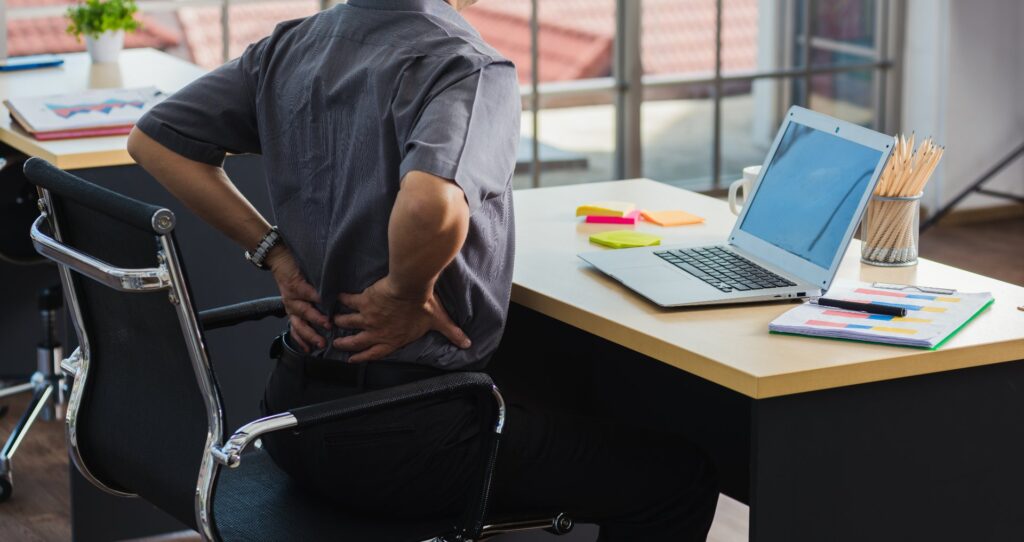In today’s digital age, many of us find ourselves glued to our desks, immersed in work that demands prolonged periods of sitting. Then after a long workday, plus overtime, we come home tired, and we rest… with more sitting, before going to bed and starting the cycle over again.
While this sedentary lifestyle may seem harmless, it poses significant health risks that often go unnoticed until they manifest as chronic issues. At Twin Oaks Telehealth Services, we understand these challenges and we are here to guide you toward a healthier, more active lifestyle, even within the constraints of your current situation.
The Hidden Dangers of Prolonged Sitting
Extended periods of sitting can lead to a range of health concerns, including:
- Musculoskeletal Disorders: Poor posture while sitting can strain the neck, shoulders, back, and legs, leading to conditions like tension neck syndrome, carpal tunnel syndrome, and lower back pain. (Yale Medicine, 2019) [1].
- Cardiovascular Issues: A sedentary lifestyle is associated with an increased risk of heart disease, obesity, type 2 diabetes, and certain cancers. (National Center for Biotechnology Information, 2017) [2].
- Circulatory Problems: Prolonged sitting can impede blood flow, increasing the risk of varicose veins and deep vein thrombosis. (OSHwiki, 2023) [3].
Beyond Standing: The Need for Movement
While standing desks have gained popularity as a solution to counteract the effects of sitting, recent studies suggest that simply standing may not be sufficient and could potentially lead to other health issues, such as circulatory problems. The key lies in incorporating regular movement throughout your day. (The Times, 2018) [4].
Practical Steps to Combat Sedentary Habits
Here are some actionable strategies to help you stay active during your workday:
- Frequent Breaks: Set a timer to remind yourself to stand and move every 30 minutes. Short, regular breaks can significantly reduce the health risks associated with prolonged sitting. (OSHwiki, 2023) [5].
- Desk Exercises: Incorporate simple stretches and exercises at your workstation to promote circulation and reduce muscle stiffness. (Sage Journals, 2018) [6].
- Active Sitting: Consider using dynamic seating options that encourage subtle movements, helping to engage your core and support better posture. (Wikipedia, 2022) [7].
- Walking Meetings: Whenever possible, opt for walking meetings or take phone calls while standing or walking to increase your daily activity levels. (Yale Medicine, 2019) [8].
- Walking Breaks: Organize a walking party with a co-worker or two (or more) and spend some of your lunch break getting fresh air, sunshine, and social wellness while walking! It’s a great way to get in a multi-faceted health investment, which is time well spent.
We Are Your Partner in Workplace Wellness
At Twin Oaks Telehealth Services, we specialize in providing virtual health consultations tailored to meet the needs of desk workers, including providing you and your company with ergonomic recommendations to help support your wellness at your desk.
Our team of experts can assess your individual situation and offer personalized guidance on ergonomics, exercise routines, and lifestyle modifications to help you mitigate the risks associated with prolonged sitting and desk work. Don’t wait for your neck, shoulders, and back to tell you with pain that they need some help; The best strategy is prevention.
Remember, it’s never too late to take control of your health. By making small, consistent changes to your daily routine, you can significantly improve your well-being and productivity. Let us assist you in this journey toward a healthier work-life balance, right from the comfort of your office.
Embrace movement, prioritize your health, and experience the transformative benefits of an active lifestyle with Twin Oaks Telehealth Services by your side.
References:
- Yale Medicine. (2019). Why Is Sitting so Bad for Us? Retrieved from (https://www.yalemedicine.org/news/sitting-health-risks)
- National Center for Biotechnology Information. (2017). Adverse Effects of Prolonged Sitting Behavior on the General Health of Office Workers. Retrieved from (https://www.ncbi.nlm.nih.gov/pmc/articles/PMC5618737/)
- OSHwiki. (2023). Musculoskeletal disorders and prolonged static sitting. Retrieved from (https://oshwiki.osha.europa.eu/en/themes/musculoskeletal-disorders-and-prolonged-static-sitting)
- The Times. (2018). Standing Desks Could Be Bad for Health. Retrieved from (https://www.thetimes.co.uk/article/standing-desks-could-be-bad-for-health-work-kj6d3lwvl)
- OSHwiki. (2023). Work-Related MSD Prevention. Retrieved from (https://oshwiki.osha.europa.eu/en/themes/work-related-musculoskeletal-disorders-prevention)
- Sage Journals. (2018). Repetitive Strain Injuries and Office Work. Retrieved from (https://journals.sagepub.com/doi/full/10.1177/2165079917737558)
- Wikipedia. (2022). Active Sitting. Retrieved from (https://en.wikipedia.org/wiki/Active_sitting)
- Yale Medicine. (2019). The Impact of a Sedentary Lifestyle on Workplace Health. Retrieved from (https://www.yalemedicine.org/news/sitting-health-risks)


